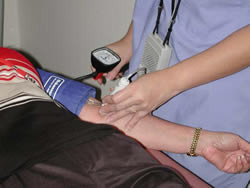What is PAD?
Peripheral Arterial Disease (PAD) is a narrowing of the blood vessels in the legs or arms caused by the build-up of fatty plaque. PAD is a strong predictor of heart disease, and may show up in leg arteries before there are any signs or symptoms in the heart. Many people experience discomfort while walking but are not aware that it is due to blocked arteries. More advanced cases can cause pain in the legs even during rest. It is estimated that up to 50 percent of patients with PAD may also have blockages in the heart arteries with no symptoms of chest pain. A frequent complication of diabetes, PAD is essentially the same condition as coronary artery disease, which it often accompanies, and is the leading cause of amputations in the U.S.
Risk factors
• Hypertension
• Smoking
• High cholesterol
• Excessive drinking
• Heart disease
• Poor diet
How we can help… 
Pacific Health and Wellness screens for arterial blockage in the peripheral arteries (away from the heart). A ratio called the Ankle Brachial Index is computed to compare systolic pressure in the ankle to that of the brachial artery to detect a risk for arterial insufficiency.
